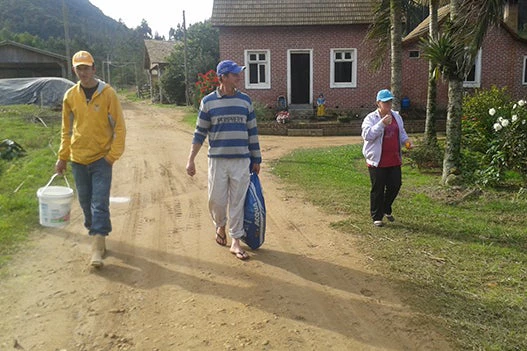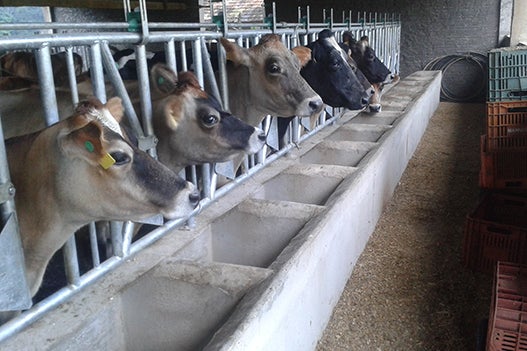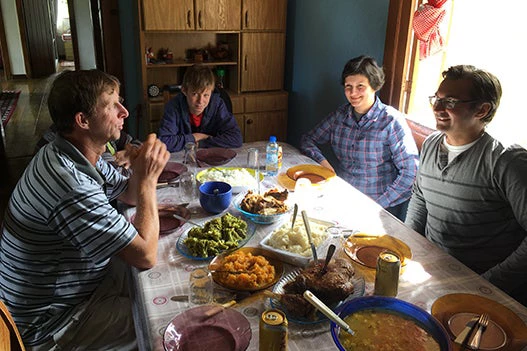
The Meyer family from Anitapolis, Santa Catarina, southern Brazil
A rude awakening by geese screaming at my door was not the way I envisioned starting my day. With temperatures near freezing, the 6.00 AM milking session seemed a daunting first task in my 12-hour internship as a family farmer in Santa Catarina, Brazil.
Luckily, after making it out the door with multiple layers of clothing, I was received by a warm “chimarrao” (a caffeine-rich infused drink typical of Southern Brazil) served by Zenaide Meyer. Together with her husband, Osni, and their son, Cleyton, Zenaide ran this farm in Anitapolis, a rural municipality over 100km West of Florianopolis, the state’s capital.
I was there to try to understand how a family farmer makes decisions about adopting new technologies. Milk production is the Meyer’s main activity, but they also grow tilapia in artificial ponds, as well as chickens, pigs, fruit trees, and maize for feeding the cows.
Within 20 minutes, all 40 cows were milked with new equipment the family acquired two months before with support from the SC Rural Program. Prior to this, they’d had to endure the laborious and time-consuming process of milking the cows by hand. “We decided to adopt this automated system not only to improve productivity and quality of the milk, but because Zenaide and I were having back problems,” said Osni.
At the cow’s feeding station, the family had also invested in improvements, but this time it was Cleyton who introduced a new technology that better controls the cows’ feed intake and helps prevent diseases that threaten them right after the milking process.
At 20 years old, Cleyton participated in a training program for young farmers that was also supported by the SC Rural Program. “After the course, I saw that with a relatively small investment in new equipment I could spend less on cow food, and also reduce the number of cows that would get sick from infections,” explained Cleyton.
Many other family-run farms in Anitapolis have adopted new technologies in recent years. Partly as a result, milk production has more than tripled over the last ten years; the city is now one of the main milk production centers in Santa Catarina.

Until recently, however, Osni and Zenaide still relied on traditional communication channels to learn about new opportunities. Because they do not use the internet at all, they still got most news and advice from the local agriculture extension agent.
But this, too, has changed. Unlike his parents, Cleyton routinely surfs the internet and constantly exchanges information through Whatsapp and other social networks. In fact, the WiFi signal in the farm was very good, thanks to a Rural ICT Inclusion Program also promoted by SC Rural, which provides Cleyton with valuable information and connections he can use to improve performance.
Osni’s mother, who bought the farm 50 years ago, is still in disbelief on how much the farm has improved. “With my now deceased husband, we would have never ever imagined that the farm could produce this much milk and food products. I can see how this recent increase in production has made everyone’s life better,” she said.
Working the rest of the day with Osni and Cleyton on the fields, rotating the cows through different grazing spots, I probed a bit more to understand why and how they made the technological improvements to the farm.
Although the results are impressive now, making those initial investments was a difficult decision. “My father lost a quarter of this property because he couldn’t repay a loan he took to buy a tractor,” said Osni, adding, “I was not ready to put my family through a similar ordeal.”
“However, after Cleyton and I did some training, we became convinced that the investment would significantly improve results and was worth the risk. Those trainings are rare, so we now take advantage of all such opportunities to learn about the future of farming,” said Osni.
But how about some of the cutting edge tools, I asked, like drone technology for decision making, or automated irrigation systems. Osni responded: “We have seen some news in the TV, but nobody has actually explained to us how it works. We do get visits from companies trying to sell us different products for improving the grass and the feed of our cows, but we can tell right away if it is worth buying or not. These new technologies that use computers and phones are harder to understand.”

There was a farmer… had a drone
In Florianopolis, a day before I met the Meyer family, I had the chance to meet 20 entrepreneurs who were in the process of starting their own businesses selling new technologies for family farmers. Osni was the type of farmer that was in their target population. Bringing precision agriculture to Osni and his family would require not only a great marketing effort, but also an adaptation of existing technologies, as most have been designed for medium- to large-scale farmers.
“We know we have a technology that can be used by family farms in Santa Catarina, but we do not have the expertise yet to be able to adapt the technology and service to each farm’s particular needs,” said Igor Silva from Bauer Aerosystems, a startup that produces high capacity drones to deliver inputs (pesticides, fertilizers) in a more precise manner where tractors are not viable.
Other firms and startups included smart irrigation systems, low-cost agrometeorological farm monitoring, electric tractors, and biofactories -- all of these in just one Brazilian state and focused exclusively on servicing the family farming segment. Clearly, there is a potential untapped market.
Large farmers already have access to these green technologies, such as precision agriculture, but when the scale is small, most of these products and services are not viable. For example, the Brazilian Government has implemented the largest Climate Smart Agriculture (CSA) Program in the world ( Plano ABC), but the program is not reaching smaller farmers. The CSA technologies need to be adapted and tailored to this segment.
How can these emerging entrepreneurs be supported to develop their business objectives? How do we reach the more than four million family farmers in Brazil, like Osni, with these technological improvements? How do we convey the message that these advances raise rural incomes and reduce the environmental footprint of farming?
In Brazil, 87% of farms are small and run by families, and they produce 40% of Brazil’s agricultural GDP on 32% of its cultivated land. During my 12-hour internship as a family farmer, I was able to see in Osni and his family a clear motivation to introduce new and green technologies to their farm, as well as the drive and passion that entrepreneurs like Igor have to reach these remote farms with new technologies.
A new green technology market for family farming is about to be launched in Brazil – it’s time for us to wake up, drink our chimarrao, ignore the weather and help them meet.


Join the Conversation